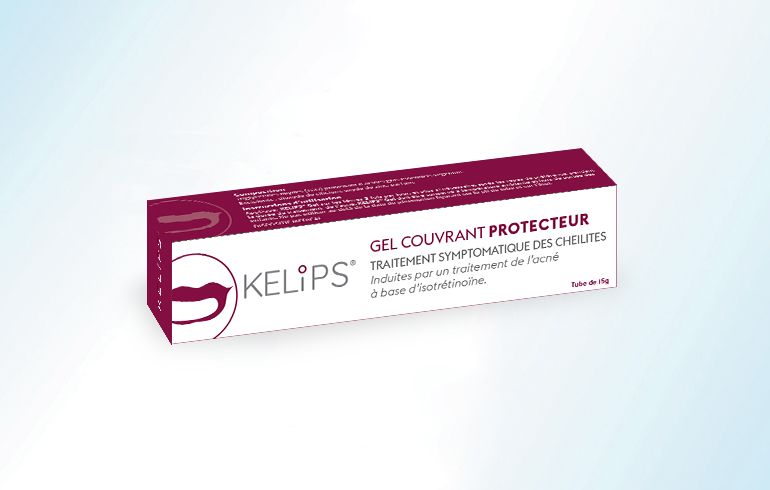
KELIPS Gel
STUDY TITLE
To evaluate the efficacy and tolerance of KELIPS® gel in the improvement of cheilitis and the prevention of its appearance at 3 months in acne patients treated with isotretinoin (principal objective).
CRO/INVESTIGATORS
Study carried out in France among 15 dermatologists in hospitals or private practice. CRO: CLINACT
STUDY DESIGN
Pilot, open, non-comparative, prospective, multi-center on 53 patients (February 2015 up to March 2016).
STUDY PROCEDURE
Inclusion period: 6 months
4 visits per patient
- M0 : Inclusion
- 1st follow up visit at 1 month
- 2ème follow up visit at 3 months
- 3ème follow up visit at 5 months
Treatment
Minimum of 3 applications per day of the gel after meals.
ASSESSMENT CRITERIA
As a preventive treatment:
- Efficiency of KELIPS® Gel in the full prevention the onset of cheilitis at 1, 3 and 5 months
As a curative treatment:
- Efficiency of KELIPS® Gel on the reduction of individual clinical signs of cheilitis.
Tolerance and acceptability criteria are as follows:
- Tolerance of the gel over a 5-month period, - Level of patient satisfaction, - Patient observance of the treatment.
RESULTS
SOBJECTIVE CLINICAL SIGNS OF CHEILITIS (ITT)
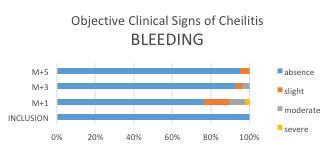
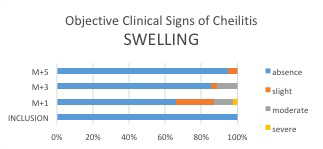
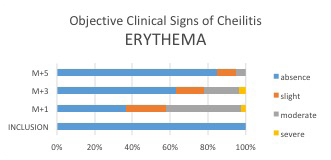
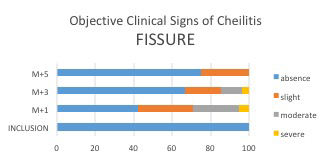
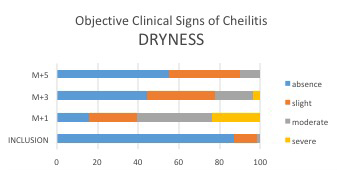
SUBJECTIVE CLINICAL SIGNS OF CHEILITIS (ITT)
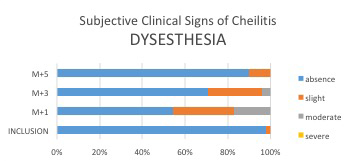
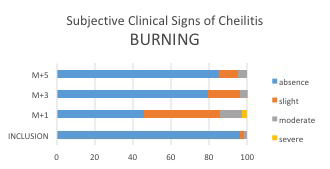
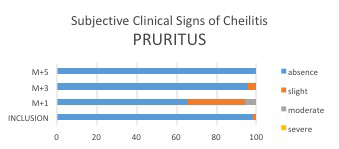
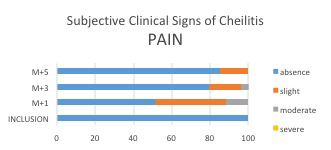
EVALUATOR CONCLUSION
The objective of the prospective, multicentric, non-comparative clinical study conducted on 53 patients was to evaluate the efficiency of the OGT gel used as a preventive and curative treatment on acne prone patients treated with isotretinoin and likely to present or presenting cheilitis. It proved that, on a preventive level, the OGT gel was efficient in 27% of all observing patients.
On a curative level, the signs of cheilitis significantly decresead as early as month 3 visit and month 5 visit with percentages of patients presenting no increase in signs and a decrease in intensity of the signs as early as month-1 visit up to month-5 visit, for all the signs. As expected, the OGT gel proved more efficient with observing patients.
In the study, only 5 patients presented minor undesirable events that were deemed attributable to the OGT gel and all resulted in full patient recovery with no after effect, on a total of 37 patients who presented 109 adverse events. The majority of adverse events having, in all logic, been attributed to the isotretinoin.’’
To evaluate the efficacy and tolerance of KELIPS® gel in the improvement of cheilitis and the prevention of its appearance at 3 months in acne patients treated with isotretinoin (principal objective).
CRO/INVESTIGATORS
Study carried out in France among 15 dermatologists in hospitals or private practice. CRO: CLINACT
STUDY DESIGN
Pilot, open, non-comparative, prospective, multi-center on 53 patients (February 2015 up to March 2016).
STUDY PROCEDURE
Inclusion period: 6 months
4 visits per patient
- M0 : Inclusion
- 1st follow up visit at 1 month
- 2ème follow up visit at 3 months
- 3ème follow up visit at 5 months
Treatment
Minimum of 3 applications per day of the gel after meals.
ASSESSMENT CRITERIA
As a preventive treatment:
- Efficiency of KELIPS® Gel in the full prevention the onset of cheilitis at 1, 3 and 5 months
As a curative treatment:
- Efficiency of KELIPS® Gel on the reduction of individual clinical signs of cheilitis.
Tolerance and acceptability criteria are as follows:
- Tolerance of the gel over a 5-month period, - Level of patient satisfaction, - Patient observance of the treatment.
RESULTS
SOBJECTIVE CLINICAL SIGNS OF CHEILITIS (ITT)





SUBJECTIVE CLINICAL SIGNS OF CHEILITIS (ITT)




EVALUATOR CONCLUSION
The objective of the prospective, multicentric, non-comparative clinical study conducted on 53 patients was to evaluate the efficiency of the OGT gel used as a preventive and curative treatment on acne prone patients treated with isotretinoin and likely to present or presenting cheilitis. It proved that, on a preventive level, the OGT gel was efficient in 27% of all observing patients.
On a curative level, the signs of cheilitis significantly decresead as early as month 3 visit and month 5 visit with percentages of patients presenting no increase in signs and a decrease in intensity of the signs as early as month-1 visit up to month-5 visit, for all the signs. As expected, the OGT gel proved more efficient with observing patients.
In the study, only 5 patients presented minor undesirable events that were deemed attributable to the OGT gel and all resulted in full patient recovery with no after effect, on a total of 37 patients who presented 109 adverse events. The majority of adverse events having, in all logic, been attributed to the isotretinoin.’’
